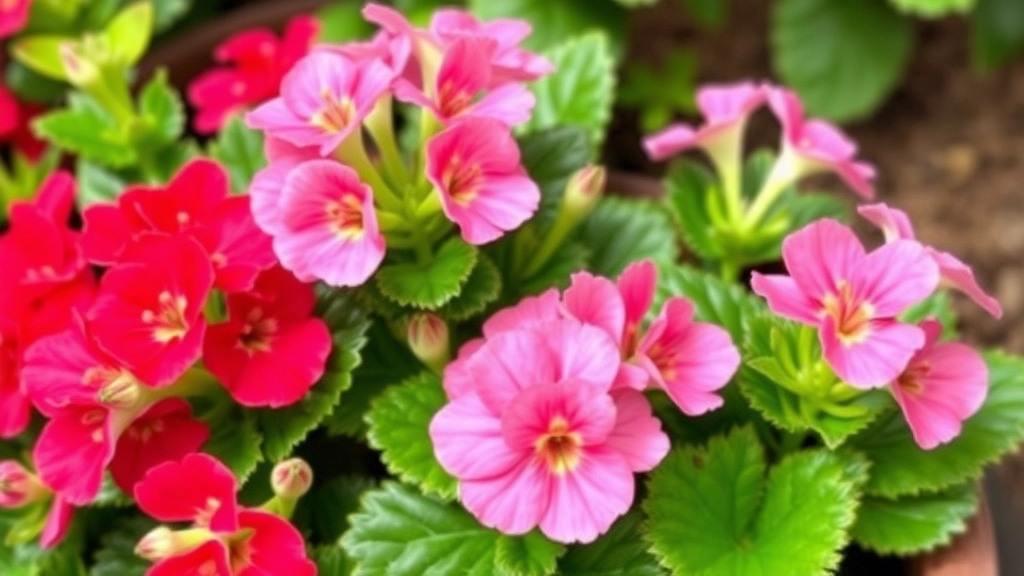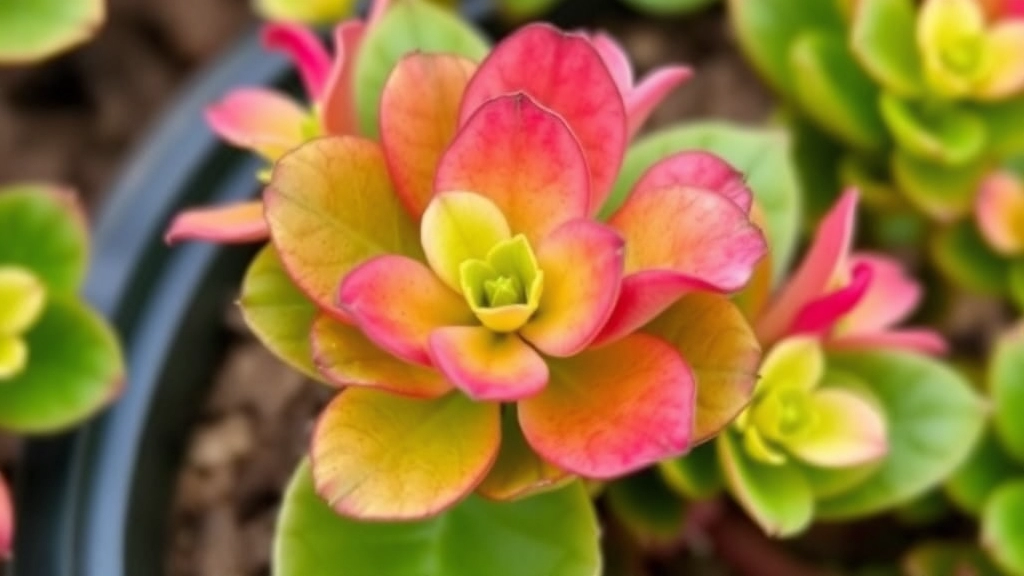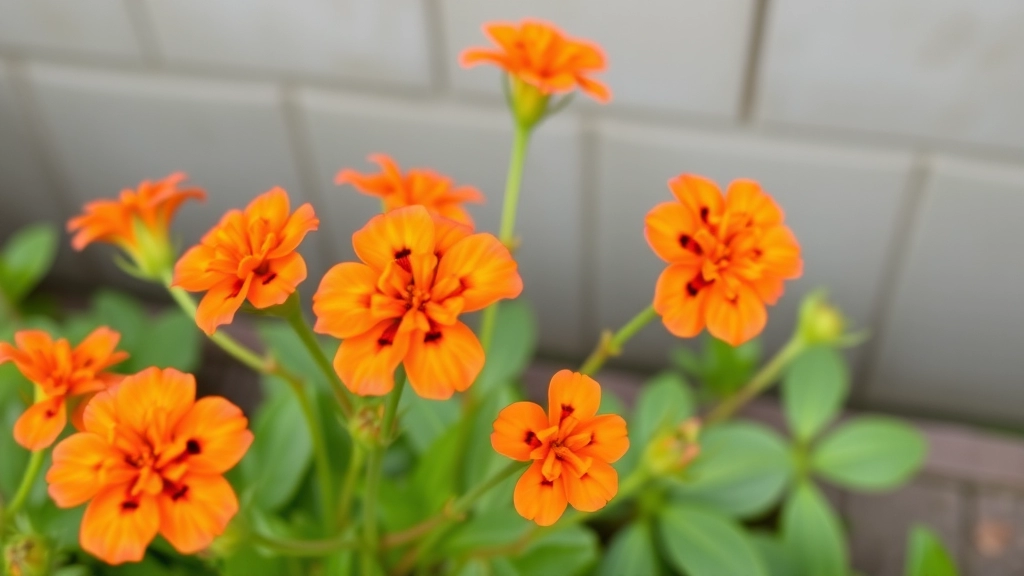Kalanchoe Orange Flowers: A Vibrant Addition
If you’re looking to add a pop of vibrant colour to your home or garden, Kalanchoe orange flowers are a fantastic choice. These hardy succulents are not only easy to care for but also offer long-lasting blooms that can brighten any space. In this guide, I’ll walk you through the best conditions for growing Kalanchoe orange flowers, from ideal lighting and soil types to watering and fertilising tips.
Understanding the Needs of Kalanchoe Orange Flowers
To ensure your Kalanchoe orange flowers thrive, it’s essential to understand their specific needs. I’ll share practical advice on how to encourage blooming, protect your plants from common pests and diseases, and even propagate new plants for an endless supply of these stunning succulents.
Transform Your Gardening Experience
Let’s dive in and transform your gardening experience with these beautiful, low-maintenance plants.
Are you struggling to grow vibrant Kalanchoe orange flowers?
Understanding the ideal conditions for these beautiful plants can make all the difference.
### Light Requirements
Kalanchoe thrives in bright, indirect sunlight.
– **Location**: Place your Kalanchoe near a south or west-facing window.
– **Duration**: Aim for at least 6 hours of light daily.
– **Avoid Direct Sun**: Too much direct sunlight can scorch the leaves.
### Temperature and Humidity
Kalanchoe prefers warm environments.
– **Ideal Temperature**: Keep the temperature between 18°C and 24°C.
– **Humidity Levels**: These plants do well in average humidity; avoid overly humid conditions.
### Soil Type
Choosing the right soil is crucial for healthy growth.
– **Well-Draining Soil**: Use a cactus or succulent mix for optimal drainage.
– **pH Level**: Aim for a slightly acidic to neutral pH (6.0 to 7.0).
### Container Choice
The right pot can enhance your Kalanchoe’s growth.
– **Drainage Holes**: Ensure the pot has drainage holes to prevent waterlogging.
– **Size**: Choose a pot that allows for growth, but not too large that it retains excess moisture.
For more detailed care tips, you might want to check out the [complete guide to growing and caring for pink Kalanchoe plants](https://planthq.org/complete-guide-to-growing-and-caring-for-pink-kalanchoe-plants/) or explore [different Kalanchoe species for your garden](https://planthq.org/explore-different-kalanchoe-species-for-your-garden/).
Watering and Fertilizing Tips for Kalanchoe

So, you’ve got your gorgeous Kalanchoe, and now you’re wondering how to keep it thriving, right?
Let’s dive into the essentials of watering and fertilising this beautiful plant.
Watering Your Kalanchoe
Watering can be a bit tricky. Too much, and you risk root rot; too little, and your plant will suffer. Here’s how to get it just right:
- Check the Soil: Stick your finger about an inch into the soil. If it feels dry, it’s time to water.
- Water Sparingly: Kalanchoe loves to be on the drier side. Water it thoroughly, but let the excess drain out.
- Frequency: During the growing season (spring and summer), water every 2-3 weeks. In winter, cut back to once a month.
Fertilizing Your Kalanchoe
Now, let’s talk about giving your Kalanchoe a little extra love with fertiliser.
- Choose the Right Fertiliser: A balanced, water-soluble fertiliser works wonders. Look for something like a 20-20-20 mix.
- Frequency: Feed your Kalanchoe every 4-6 weeks during the growing season. Skip the fertiliser in winter when the plant is dormant.
- Dilution is Key: Always dilute the fertiliser to half strength. This prevents any potential shock to your plant.
Signs of Over or Under-Watering
Keep an eye out for these telltale signs:
- Over-Watering: Yellowing leaves and mushy stems.
- Under-Watering: Wrinkled leaves and a droopy appearance.
How to Encourage Blooming in Kalanchoe
Are you struggling to get your Kalanchoe to bloom? You’re not alone. Many plant enthusiasts face this challenge.
To encourage your Kalanchoe to produce those vibrant orange flowers, consider the following tips:
- Light Exposure: Kalanchoe thrives in bright, indirect sunlight. Aim for at least 6 hours of light daily. Too little light can hinder blooming.
- Temperature Control: Keep the temperature between 18°C and 24°C. Sudden temperature drops can stress the plant and reduce flowering. For more detailed guidance, check out the ideal temperature for Kalanchoe Blossfeldiana growth.
- Watering Routine: Allow the soil to dry out between waterings. Overwatering can lead to root rot, which affects blooming.
- Fertilizing: Use a balanced, water-soluble fertilizer every 4-6 weeks during the growing season. This will provide essential nutrients for flower production.
- Pruning: After blooming, prune back the spent flowers and any leggy growth. This encourages new growth and future blooms.
- Rest Period: After the blooming cycle, give your Kalanchoe a rest period. Reduce watering and stop fertilizing for about 6 weeks. This helps the plant gather energy for the next bloom. If your Kalanchoe is still not flowering, explore the top reasons and fixes for non-flowering Kalanchoe.
By following these simple steps, you can create the ideal environment for your Kalanchoe to flourish and bloom beautifully.
Common Pests and Diseases of Kalanchoe

As we delve deeper into caring for your Kalanchoe, it’s crucial to be aware of the common pests and diseases that can affect its health.
Pests to Watch Out For
Kalanchoe plants can fall victim to several pests that may compromise their beauty and vitality. Here are the most common culprits:
- Aphids: Tiny, soft-bodied insects that suck the sap from your plant, leading to stunted growth.
- Mealybugs: These pests appear as white, cotton-like clusters on the leaves and stems, causing leaf drop and weakening the plant.
- Spider Mites: Often found on the undersides of leaves, these minuscule pests create webbing and can cause leaf discolouration.
- Scale Insects: Small, oval-shaped insects that attach themselves to stems and leaves, resulting in yellowing foliage.
Diseases to Be Aware Of
In addition to pests, Kalanchoe can also suffer from various diseases that can hinder its growth. Here are a few to keep an eye on:
- Powdery Mildew: A fungal disease that manifests as a white powdery coating on leaves, often due to high humidity and poor air circulation.
- Root Rot: Caused by overwatering, root rot leads to wilting and yellowing leaves, and can ultimately kill the plant if not addressed promptly.
- Leaf Spot: This condition is characterised by dark spots on leaves, often due to fungal infections or overwatering.
Prevention and Treatment
To keep your Kalanchoe thriving, consider these preventive measures and treatments:
- Regular Inspections: Check your plants weekly for any signs of pests or diseases.
- Proper Watering: Ensure you are not overwatering, which can lead to root rot.
- Good Air Circulation: Place your Kalanchoe in a well-ventilated area to reduce humidity and prevent fungal diseases.
- Insecticidal Soap: Use this to treat infestations of pests like aphids and mealybugs.
- Remove Affected Leaves: If you notice diseased leaves, trim them off to prevent the spread.
Propagating Kalanchoe for More Plants
Are you looking to expand your Kalanchoe collection without breaking the bank?
Propagating Kalanchoe is a straightforward and rewarding process that anyone can try.
Methods of Propagation
- Leaf Cuttings
- Select healthy leaves from the parent plant.
- Cut them off cleanly, ideally with a sharp, sterilised knife.
- Allow the cut edges to dry for a day or two to form a callus.
- Place the leaves in well-draining soil, burying the cut edge slightly.
- Water sparingly until roots develop.
- Stem Cuttings
- Choose a healthy stem and cut it just below a leaf node.
- Remove the lower leaves to expose the stem.
- Let the cut end dry for a few days to callus.
- Plant the cutting in soil, ensuring the node is buried.
- Water lightly and keep in a bright spot until roots form.
- Offsets
- Some Kalanchoe varieties produce offsets, or âpups,â at their base.
- Gently separate these from the parent plant.
- Replant them in their own pots with well-draining soil.
- Water lightly and provide bright, indirect light.
Tips for Successful Propagation
- Timing: Early spring is ideal for propagation, as the plant is entering its active growth phase.
- Environment: Ensure a warm, bright location without direct sunlight to avoid scorching the cuttings.
- Humidity: Consider using a plastic bag or a humidity dome to maintain moisture during the rooting process.
If you’re interested in more detailed steps, check out our guide on propagating Kalanchoe Mother of Thousands for specific tips and tricks. Additionally, for a broader understanding of various Kalanchoe propagation methods, visit our Kalanchoe Maternity Plant care and propagation guide.
Pruning and maintenance are key to ensuring your Kalanchoe continues to thrive and produce those stunning orange flowers.
### Why Prune?
Pruning isn’t just about making your plant look neat. It helps to:
– **Promote Air Circulation:** This reduces the risk of pests and diseases.
– **Encourage New Growth:** Cutting back old stems can stimulate fresh, healthy growth.
– **Shape Your Plant:** Keep your Kalanchoe looking bushy and full instead of leggy.
### When to Prune?
Timing is everything.
– **After Blooming:** Wait until the flowers fade. This is the perfect time to tidy up.
– **Spring:** A light trim in spring can encourage a burst of growth as the weather warms.
### How to Prune?
Here’s a simple step-by-step guide:
1. **Gather Your Tools:** You’ll need clean, sharp scissors or pruning shears.
2. **Identify Dead or Yellowing Leaves:** These are the first to go.
3. **Trim Back Stems:** Cut back to just above a leaf node. This encourages new branches to sprout.
4. **Remove Spent Flowers:** Snip off any dead flowers to keep your plant looking its best.
### Maintenance Tips
Keeping your Kalanchoe healthy goes beyond just pruning. Here are some easy maintenance tips:
– **Dust Leaves:** Wipe leaves with a damp cloth to keep them clean and photosynthesising effectively.
– **Check Soil Moisture:** Always check before watering. Kalanchoe prefers to dry out a bit between waterings.
– **Fertilize Sparingly:** Use a balanced fertiliser every few months during the growing season.
For more detailed care instructions, you might find our [Florist Kalanchoe Plant Care](https://planthq.org/florist-kalanchoe-plant-care-essential-tips-for-healthy-growth/) guide helpful. Additionally, if you’re dealing with any leaf issues, our article on [Why Are My Kalanchoe Leaves Dying](https://planthq.org/why-are-my-kalanchoe-leaves-dying-causes-solutions/) offers valuable insights.
FAQs about Kalanchoe Orange Flowers
How often should I water my Kalanchoe?
During the growing season (spring and summer), water your Kalanchoe every 2-3 weeks. In winter, reduce the frequency to once a month. Always check the soil moisture before watering.
What type of fertiliser is best for Kalanchoe?
A balanced, water-soluble fertiliser, such as a 20-20-20 mix, is ideal. Dilute it to half strength and apply every 4-6 weeks during the growing season. Avoid fertilising in winter.
What are the signs of over-watering and under-watering?
Over-watering can cause yellowing leaves and mushy stems, while under-watering can lead to wrinkled leaves and a droopy appearance.
What pests commonly affect Kalanchoe plants?
Kalanchoe plants can be affected by aphids, mealybugs, spider mites, and scale insects. Regular inspections can help catch these pests early.
How can I prevent and treat diseases in my Kalanchoe?
To prevent diseases, ensure proper watering, good air circulation, and regular inspections. For treatment, use insecticidal soap for pests and remove affected leaves to prevent the spread of diseases.
What should I do if my Kalanchoe shows signs of root rot?
If you suspect root rot, reduce watering immediately and ensure the soil has good drainage. You may need to repot the plant in fresh, well-draining soil.
Why are my Kalanchoe leaves turning yellow?
Yellow leaves can be a sign of over-watering, poor drainage, or nutrient deficiencies. Check your watering habits and fertiliser use to address the issue.
How can I improve air circulation for my Kalanchoe?
Place your Kalanchoe in a well-ventilated area, away from other plants. You can also use a small fan to improve air movement around the plant.
Is it normal for Kalanchoe to drop leaves?
Leaf drop can occur due to stress from pests, diseases, or improper care. Identify and address the underlying issue to prevent further leaf drop.
References
-
Kalanchoe Plant Care â How To Grow A Kalanchoe
-
How to Grow and Care for Kalanchoe
-
Kalanchoe: How to Grow and Care for Kalanchoe Plants
